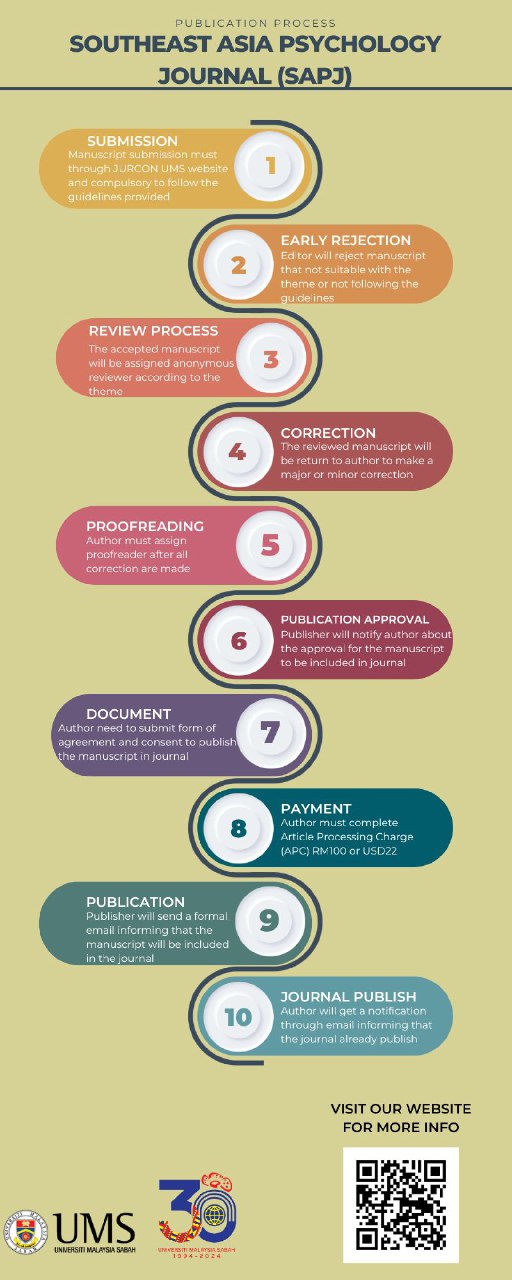ARE THEY EMOTIONALLY – SOCIALLY INTELLIGENT? EXAMINING EMOTIONAL-SOCIAL INTELLIGENCE AMONG ADOLESCENTS RESIDING IN A CHILDREN’S HOME IN THE STATE OF SABAH, MALAYSIA
DOI:
https://doi.org/10.51200/sapj.v8i1.5125Keywords:
Sabah, Malaysia, Children’s Home, Emotional Intelligence, Emotional Quotient, Institutionalized AdolescentAbstract
This study was conducted to investigate emotional-social intelligence among adolescent in a Children’s Home located Sabah, Malaysia. A total of 49 adolescents (11 males and 38 females) aged between 12 and 18-years-old were selected through purposive sampling to participate in the study. BarOn Emotional Quotient Inventory: Youth Version was used to collect quantitative data regarding
the respondents' experiences concerning emotional and social intelligence. In general, analysis shows that emotional-social intelligence among adolescent in this Children’s Home was reported to be low. No difference in emotional-social intelligence across gender and age groups was found. Stress management skill was the only domain found to be different between male and female adolescents. There were no major relations among emotional-social intelligence features. It was found that only adolescents’ skills of interpersonal and adaptability was moderately positively correlated. Information found from this study is deemed meaningful for the purpose of planning an intervention program to empower emotional intelligence among adolescent residing in children’s' homes.
References
Appelbaum, S. A. (1973). Psychological mindedness: Word, concept, and essence. International Journal of Psycho-Analysis, 54, 35-46.
Bar-On, R. (1997a). The emotional quotient inventory (EQ:i). Toronto, Canada: Multi-Health Systems, Inc.
Bar-On, R. (1997b). The emotional quotient inventory (EQ:i): Technical manual. Toronto, Canada: Multi-Health Systems, Inc.
Bar-On, R. (2000). Emotional and social intelligence. Insight from the emotional quotient inventory (EQ-i). In R. Bar-On, & J. D. A. Parker (Eds.), The Handbook of Emotional Intelligence (pp. 363388). San Francisco: Jossey- Bass.
Bar-On, R. (2006). The Bar-On model of emotional-social intelligence (ESI). Psicothema, 18 (supl.), 13-25.
Bar-On, R., & Parker, J. D. A. (2000). BarOn emotional quotient inventory: Youth version (BarOn EQ-i: YV): Tehcnical manual. Toronto, Canada: Multi-Health Systems, Inc.
Fernández-Berrocal, P., Cabello, R., Castillo, R., & Extremera, N. (2012). Gender differences in emotional intelligence: The mediating effect of age. Psicologia Conductual, 20(1), 77-89.
Bhat, R. H. (2017). Emotional intelligence of adolescents in relation to their test anxiety and academic stress. Rehabilitation Sciences, 2(1), 21 25.
Cabello, R., Sorrel, M. A., Fernández-Pinto, I., Extremera, N., & Fernández-Berrocal, P. (2016). Age and gender differences in ability emotional intelligence in adults: A cross-sectional study. Developmental Psychology, 52(9), 1486-1492.
Cakan, M., & Altun, S. A. (2005). Adaptation of an emotional intelligence scale for Turkish educators. International Education Journal, 6(3), 367-372.
Chapin, F. S. (1942). Preliminary standardization of a social impact scale. American Sociological Review, 7, 214-225.








